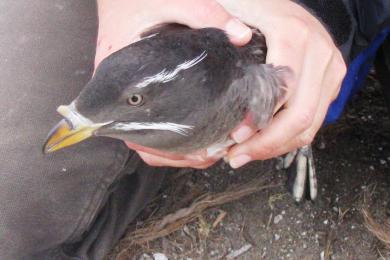Rhinoceros and Cassin’s Auklets, lesser-known relatives of the colorful Puffins, are seabirds that nest on Año Nuevo Island in burrows that they excavate with their sharp toes. Rhinoceros Auklets may also dig using their “rhino” horn—the unique namesake horn that grows at the base of their bill during the breeding season. Both species are active above ground only under cover of darkness.
Rhinoceros Auklets are about the size of a small chicken and nest in significant numbers on only three islands in California—the Farallons, Castle Rock (near Crescent City), and Año Nuevo Island. Cassin’s Auklets are about the size of a blackbird, nest on the same islands in California as Rhinoceros Auklets, and also nest on the Channel Islands in Southern California. The secretive nature of auklets makes them hard to see from shore, but these seabirds are a unique feature of our central coast and an indicator of the ecological health and wildness of our coast-side state parks.
In 2013, about 260 Rhinoceros Auklets and 100 Cassin’s Auklets nested on Año Nuevo Island. Rhinoceros Auklets went extinct (as a breeding species) in California in the 1800s due to disturbances associated with lighthouse operations on the few islands in the state with suitable breeding habitat. Rhinoceros Auklets naturally colonized Año Nuevo Island in the 1980s after non-native rabbits were removed—the rabbits had out-competed the auklets for burrow space. All seemed well for the new auklet colony, but the specter of the rabbits remained—they had contributed to the degradation of the native plant community at Año Nuevo Island by eating most of the plants. The legacy of the rabbits, habitat manipulations during the days of lighthouse operation, and a rapidly growing number of plant-trampling California sea lions visiting the island all combined to cause a virtually complete loss of Año Nuevo Island’s native vegetation in the 1990’s.
This was problematic for the burrow-nesting auklets. The soil at Año Nuevo Island is sandy; and without plants to hold it together, erosion became a major issue. Burrows started to collapse, sometimes killing chicks or adults, and nesting habitat was literally blowing away on the wind. As one of only three significant Rhinoceros Auklet breeding colonies in the state (and with no other predator-free island habitat to switch to), the loss of the colony at Año Nuevo would have been a major blow to the species’ recovery. After nearly two decades of monitoring the island’s seabirds, scientists at the non-profits Oikonos Ecosystem Knowledge and Point Blue Conservation Science knew that something needed to be done to save the colony. Oikonos, a non-profit that works worldwide to research and conserve imperiled ecosystems, worked with Año Nuevo State Park and a diverse set of other partners to devise a restoration plan, which was implemented in 2010. The project was paid for via funds allotted for restoring damage caused by the S.S. Jacob Luckenbach oil spill. The S.S. Luckenbach sank off Half Moon Bay in the 1950s and periodically spewed oil until the 1990s. The spills killed thousands of seabirds, including Rhinoceros Auklets from Año Nuevo Island.
The auklets’ nesting habitat on the island was protected from trampling by sea lions by installing a “habitat ridge” around the breeding colony. This structure excludes sea lions from the core of the auklets’ nesting area (about 1 acre of the 14-acre island). Students in a class at California College of the Arts helped design clay nest “modules”—specialized birdhouses installed underground that mimic natural auklet burrows and provide auklets with safe nesting sites. To address the fundamental problem—erosion—Oikonos and partners installed tens of thousands of native plants, which slow erosion with their extensive root networks. The drought-tolerant native plants responded well to the high levels of nutrients on the island (think bird guano), and native salt grass and American dune grass now hold the soil together throughout the breeding colony. Burrow erosion has dropped dramatically since the restoration began, and the auklets’ future is looking more secure.
Some side-benefits also came from the restoration project. Cassin’s Auklets had colonized the island in the 1990’s and small numbers have nested there ever since. Since 2010, however, the population has grown rapidly and doubled from around 50 birds in 2011 to 100 birds in 2013. This may be due in part to oceanic processes and food availability (Cassin’s Auklets eat krill), but the smaller Cassin’s Auklets have also been utilizing the ceramic nest modules and moving into areas of the island with tall grass that provides protective cover. Western Gulls have also enjoyed the new vegetation, using it for nesting material and cover for their vulnerable chicks.
The new vegetation has already successfully withstood the tests of severe weather, unusual numbers of roosting pelicans last fall, and our current drought. Oikonos continues to monitor the restoration’s success and the populations of all seabirds on the island, and continues to plant small numbers of native plants each fall. When you’re out at Año Nuevo enjoying the elephant seals, make sure to appreciate the island as well—it’s a jewel of our central coast, a rare safe haven for seals and seabirds alike.

